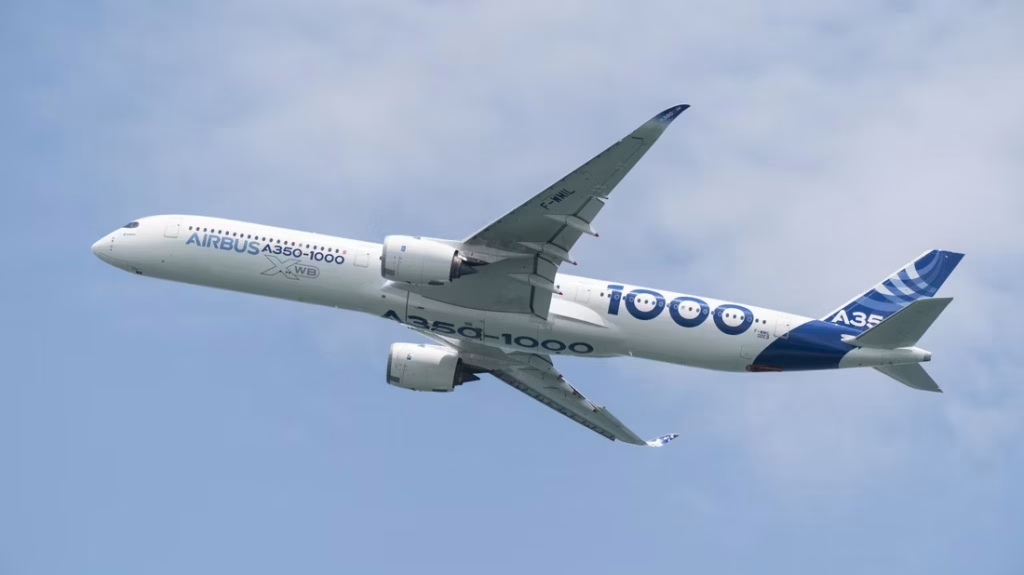Global Avionics Round-Up from Aircraft Value News (AVN)
The increasing prevalence of autonomous aviation aligns with broader technological advancements within avionics. The A350-1000 is a test case.

The Airbus A350-1000 jet aircraft widebody airliner that has successfully completed a series of test flights demonstrating its capability to perform fully autonomous taxiing, takeoffs, and landings. (Photo: Airbus)
Autonomous aircraft are rapidly emerging as one of the biggest game-changing trends in aviation, poised to reshape the industry well into 2025 and beyond. Innovations in autonomous flight technology have made remarkable strides, particularly in enhancing cockpit automation, setting the stage for a future where fully self-piloted planes could become a reality.
A key player in this revolution is the Airbus A350-1000, a widebody airliner that has garnered attention for its groundbreaking achievements. In recent months, the A350-1000 successfully completed a series of test flights, demonstrating its capability to perform fully autonomous taxiing, takeoffs, and landings.
These developments underscore the potential of autonomous systems to redefine how commercial aircraft operate, offering improved efficiency, safety, and cost-effectiveness.
The growing trend of autonomous aviation aligns with broader technological advancements, such as AI and machine learning, which are making aircraft avionics smarter and more responsive.
As Airbus continues to test and refine these capabilities, the A350-1000 stands at the forefront of this shift, highlighting the industry’s push towards a future where pilots may serve more as overseers than active controllers.
The A350-1000 is a wide-body, long-haul aircraft that represents one of Airbus’s most advanced and efficient jets in its A350 XWB (Extra Wide Body) family. It was designed to offer improved fuel efficiency, enhanced aerodynamics, and greater passenger comfort compared to its predecessors, with a seating capacity of about 350-410 passengers, depending on the configuration.
The A350-1000’s range of up to 8,700 nautical miles allows it to serve ultra-long-haul routes, making it popular with airlines looking to operate high-capacity flights on lengthy international trips.
Airbus chose the A350-1000 as the platform to lead its autonomous development initiatives for several reasons.
The A350-1000 is one of the most advanced aircraft in terms of avionics and systems integration. It features cutting-edge fly-by-wire technology, which allows greater computer control over the flight systems. This makes it a natural choice for pushing into the realm of autonomy, where reliable, advanced avionics systems are essential.
The A350-1000’s architecture is designed to integrate new technologies, including autonomous systems. Airbus’s approach to avionics and aircraft control systems on this model allows for software updates and modifications, making it easier to add new capabilities like autonomous flight control over time.
Autonomous flying requires advanced sensors, data processing units, and machine learning algorithms to manage tasks like taxiing, takeoff, cruising, and landing without human intervention. The A350-1000 is equipped with sophisticated sensors, radar systems, and AI-driven avionics, making it capable of integrating these developments.
The A350-1000’s systems feature multiple layers of redundancy, meaning that critical systems are duplicated to ensure continued operation in the event of a failure. This robustness is crucial for the progression toward full autonomy, as safety is the primary regulatory hurdle.
Airbus has already begun using the A350-1000 for autonomous taxiing, takeoff, and landing trials. These recent Autonomous Taxi, Takeoff, and Landing (ATTOL) tests have shown that the A350-1000 can execute such maneuvers without pilot input, relying on sensor fusion, computer vision, and AI systems to handle the process.
As part of the broader ecosystem for autonomy, Airbus is working on advanced air traffic management systems. The A350-1000’s communication systems will be pivotal in helping autonomous aircraft interact with other planes and ground-based systems, ensuring safe and efficient operation in increasingly crowded skies.
By using the A350-1000 as a testbed, Airbus is positioning this aircraft to serve as a blueprint for autonomous capabilities across its future models. Lessons learned from the A350-1000’s autonomous trials will likely trickle down to other aircraft, including narrow-body and regional jets.
This article also appears in the October 7 issue of our partner publication Aircraft Value News.
John Persinos is the editor-in-chief of Aircraft Value News. You can reach John at: [email protected]